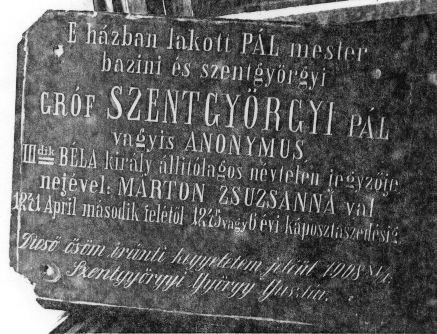
Digital scan by Daniel B. Sedory of a paper photocopy provided by Paul Hinlicky
(The plaque was moved to the Museum of Sabinov in 1990 or 1991.)

Digital scan by Daniel B. Sedory of a paper photocopy provided by Paul Hinlicky
The text on the plaque is Hungarian:
The best we can do at translating this into English:
Some of the words on this plaque and in the 1908 book written by György Gusztáv Szentgyörgyi are very difficult even for Hungarians to understand today! From a recent computer dicitionary, I found that the word, állítólagos, may mean: "alleged, reputed, ostensible, self-styled" and állítólag: "reputedly, reportedly, professedly, allegedly." And jegyzõkönyv is a: "record, report or proceedings;" a jegyzõkönyvvezetõ being a "court reporter." But what did the phrase, állitólagos névtelen jegyzője mean to our author back in 1908? Here you'll find a sort of concordance or word commentary for most of the Hungarian words on this plaque:
ház = home, place, house; -ban = in, at thus:
E házban = In this house.
lakott = lived (as in residing in a place; lakozik = to reside in)
Pál = Paul (Given or 'first' name)
mester = Master
bazini = ? [ An area known as Bazinsky in Slovakia? ]
és = and, more
szentgyörgyi = [ An area known as Svätojursky in Slovakia? ]
gróf = Count, Earl (a title of nobility)
Szentgyörgyi = [Surname] Click here: For more on the meaning of the names Szegyory and Szentgyörgyi.
vagyis = that is, in a word, namely
ANONYMUS =
király = King; IIIdik Béla = Béla the Third (ruled 1173-1196).
névtelen = faceless, unnamed, nameless, anon, anonymous
állitólagos névtelen jegyzője = ? [ Difficult to say for sure,
yet this is one of the most important phrases here!! ]
neje = (this is an old term for lady or wife); -vel = with or by thus:
nejével = with his wife.
Marton = [ her 'maiden' or Surname ]
Zszsuanna = Susan ( her Given or 'first' name)
val = (Difficult to know why this word is here; doesn't seem to fit).
második = second; [ fél = half] and -től = from; since thus:
1241 April második felétől = from the second half of April 1241.
vagy = else, or thus: '1245 or 6'
évi = annual; -ig = to; up to; till, until; for; káposzta = cabbage;
[szedés = typesetting, _picking_, matter, setting; szedett = picked ]
thus: évi káposztaszedésig = until the annual
cabbage picking (or harvest).
Dicső = honorable; glorious
ősőm irúnti ... = Difficult to ascertain becuase I'm not even sure of the words due to poor quality of the photocopy here!
1908 XI/I. = 1908 November / 1st